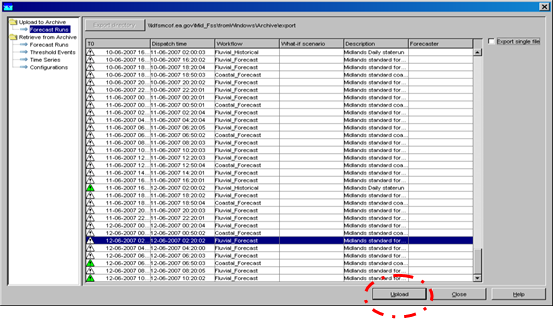<p><br /></p> |
Since release 2017.02 the archive tasks discussed below are not supported anymore.
The archiving display is used to archive forecasts and to retrieve previously archived forecasts from a central server. The concept is that all the individual pieces of data used to create the forecast (only from the forecast workflow) are saved so that the forecast can be rerun at any point in the future with exactly the same result. This is useful for post event analysis of forcasting and model performance.
To manually archive a single forecast, open the Operator Client where the forecast was run. Select Archiving from the Tools Menu, Select Forecast Runs filter under Upload to Archive. Select the forecast that you want to archive and click on Upload.

This forecast is then written to a zip file and stored in the file shares. If configured (deployed) an archiver process can pick up these zip files and process them.
Users can also archive several forecasts to one archive file by checking the Export Single File box in the top right hand corner of the archive window.
The Standalone System is the only system that archives can be imported to. In order to import archives, you should use a Standalone that only contains the latest configuration. You can do this by copying the config folder of an Operator Client to the Standalone or by deleting the local datastore of an Operator Client and downloading the configuration using the Configuration Management Tool, then copying the local datastore from the Operator Client to the Standalone.

In the Standalone System, select Archiving from the Tools Menu. Select the Forecast Runs filter under Retrieve from Archive. Then press the Import file button. This enables you to select zip files of any type. Navigate to the correct location (anywhere on your network or local pc) and select one or more Forecast Run Archives.
You can then view these forecasts by opening the Forecast Management Display and they will be listed under forecasts in local datastore. To view the results of the required forecast- select it in the list and then click Open and it will appear in the bottom left hand corner of the screen. Double click on this to set the system time to the T0 of the open forecast. You can then view the results in the pre-configured displays.
As in a) except you need to select Threshold Events under Retrieve from Archive. To view Threshold Events you need to open the Skill Scores Display.
As in a) except you need to select Time Series under Retrieve from Archive. To view Time Series you need to open the pre-configured displays for Performance.
Please note: You cannot import archived configurations directly into your standalone system.
In the case that the REGION_HOME variable of the FSS or OC creating the archives does not match the requested regionId for the archive, it is possible to explicitly configure a regionId in the explorer.xml configuration file:
<systemInformation>
<systemCaption>KRW-VSS Analyse Tool (versie Release 1)</systemCaption>
<systemHelpFile>%REGION_HOME%\help.pdf</systemHelpFile>
<regionId>KRW_VSS</regionId>
</systemInformation>
|